THE AMERICAN COLONIAL AND CONTEMPORARY TRADITIONS ...
THE AMERICAN COLONIAL AND CONTEMPORARY TRADITIONS ...
THE AMERICAN COLONIAL AND CONTEMPORARY TRADITIONS ...
You also want an ePaper? Increase the reach of your titles
YUMPU automatically turns print PDFs into web optimized ePapers that Google loves.
and Harry Belafonte visited the Philippines, Filipino singers tried hard to sound just<br />
like them. The popular noontime show Student Canteen even launched contests to<br />
search for the local versions of Elvis Presley (Eddie Mesa) and Johnny Mathis (Bert<br />
Nievera). Diomedes Maturan, winner of Tawag ng Tanghalan, another amateur<br />
singing contest, imitated Perry Como. Victor Wood aped Tom Jones, and the Platters<br />
had their alter egos in the Splatters.<br />
In the meantime, there were some original compositions based on the new styles.<br />
Among these were Clod Delfino’s “ Hahabol-habol ” (In Pursuit), popularized by<br />
Bobby Gonzales and Sylvia La Torre, and the country and Western style “Pitong<br />
Gatang” (Seven Ganta) sung by Fred Panopio. The battery-operated transistor<br />
radio and 45-rpm records made popular music accessible to a broader audience.<br />
In the 1960s, rock ‘n’ roll reached its peak. During the first half of the decade,<br />
instrumental groups such as The Ventures and The Shadows inspired many<br />
young people to learn how to play the guitar. The phenomenal rise of The<br />
Beatles towards the mid-1960s provided the impetus for the emergence of<br />
other pop groups. These included the Rolling Stones, Cream, The Doors, Jimi<br />
Hendrix, Janis Joplin, Chicago, Procol Harum, and Santana.<br />
The local pop music industry grew as radio and TV shows, such as the Night Owl<br />
Dance Party and Jam Session, promoted the latest dance craze. Discotheques<br />
competed with cocktail lounges. Local groups imitated The Beatles and other<br />
pop idols. The commercially successful groups in the 1960s include The<br />
Moonstrucks, Hijacks, Electro Maniacs, R.J. and The Riots, and The Deltas.<br />
They popularized rock ‘n’ roll, the twist, “mashed potato,” and watusi.<br />
Pinoy Ballads. Most local compositions in the 1960s were love songs, such<br />
as those by Antonio Maiquez, Mike Velarde, Manuel Villar, and others. Ballads,<br />
later called “middle of the road,” were written by Alice Doria Gamilla (“A Million<br />
Thanks to You”), Jose Mari Chan (“Afterglow,” “Deep in My Heart”), and<br />
Willy Cruz (“Never Say Goodbye”). Leading arrangers included Danny Holmsen,<br />
Pastor de Jesus, Nestor Robles, and Josefino Cenizal.<br />
Pilita Corrales, Carmen Soriano, Carmen Pateña, Mercy Molina, Ric Manrique,<br />
and other local singers developed their own styles, departing from the usual trend<br />
of merely imitating foreign idols. Later, a younger generation of recording artists<br />
led by Nora Aunor, Tirso Cruz III, and Eddie Peregrina emerged. Among the<br />
singing groups of the 1960s, The Ambivalent Crowd, The Sheraders, and The<br />
Fourth Generation figured prominently.<br />
In the 1970s popular music was “Filipinized” and made more “earthy” partly as a<br />
result of the nationalist reawakening in that decade. More and more composers<br />
began to use street lingo to deliver their message. Inspired by the commercial<br />
success of “ Hahabol-habol ” and Pilita Corrales’ winning the “Best Singer” award<br />
at the Tokyo Music Festival for her rendition of George Canseco’s “My

















